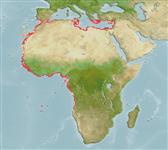Environment: milieu / climate zone / profondeur / distribution range
Écologie
marin démersal; profondeur 90 - 220 m (Ref. 5222). Subtropical; 37°N - 16°S, 19°W - 37°E (Ref. 5222)
Eastern Atlantic: Mediterranean to southern Angola.
Taille / Poids / Âge
Maturité: Lm ? range ? - ? cm
Max length : 125 cm TL mâle / non sexé; (Ref. 111103); poids max. publié: 25.0 kg (Ref. 5222)
Épines dorsales (Total) : 11; Rayons mous dorsaux (Total) : 14 - 15; Épines anales: 3; Rayons mous anaux: 9. Distinguished by the following characteristics: dark brown head and body color; soft dorsal, caudal and anal fins blackish distally, basal part lighter; white edge on caudal and pectoral fins; blackish pelvic fins; black streak on cheek at the upper edge of maxilla; depth of body contained 2.4-2.8 times in SL; head length 2.2-2.4 times in SL; convex interorbital area; subangular preopercle, with enlarged serrae at the angle, lower edge with 1-6 small serrae; posterior nostrils 2-3 times larger than anterior nostrils; maxilla naked, not reaching posterior to eye; 2 rows of teeth on midlateral part of lower jaw, inner teeth distinctly larger than outer teeth (Ref. 89707).
Body shape (shape guide): fusiform / normal; Cross section: compressed.
Deep-water species. Occurs on mud, sand, or rocky bottoms (Ref. 89707).
Life cycle and mating behavior
Maturité | Reproduction | Frai | Œufs | Fécondité | Larves
Heemstra, P.C. and J.E. Randall, 1993. FAO Species Catalogue. Vol. 16. Groupers of the world (family Serranidae, subfamily Epinephelinae). An annotated and illustrated catalogue of the grouper, rockcod, hind, coral grouper and lyretail species known to date. Rome: FAO. FAO Fish. Synop. 125(16):382 p. (Ref. 5222)
Statut dans la liste rouge de l'IUCN (Ref. 130435: Version 2025-1)
Menace pour l'homme
Harmless
Utilisations par l'homme
Pêcheries: intérêt commercial mineur
Outils
Articles particuliers
Télécharger en XML
Sources Internet
Estimates based on models
Preferred temperature (Réf.
123201): 14.2 - 17.1, mean 15.6 °C (based on 37 cells).
Phylogenetic diversity index (Réf.
82804): PD
50 = 0.5000 [Uniqueness, from 0.5 = low to 2.0 = high].
Bayesian length-weight: a=0.01148 (0.00662 - 0.01991), b=3.05 (2.91 - 3.19), in cm total length, based on LWR estimates for this species & Genus-body shape (Ref.
93245).
Niveau trophique (Réf.
69278): 4.0 ±0.7 se; based on size and trophs of closest relatives
Résilience (Réf.
120179): Très faible, temps minimum de doublement de population supérieur à 14 ans (Preliminary K or Fecundity.).
Fishing Vulnerability (Ref.
59153): High to very high vulnerability (75 of 100).
🛈
